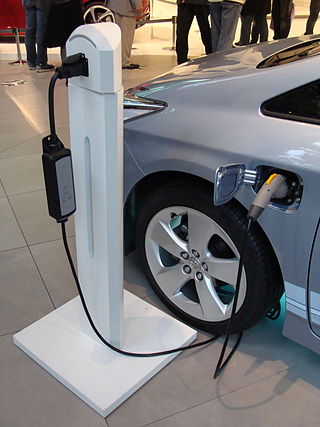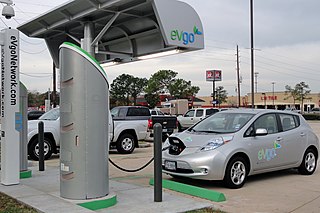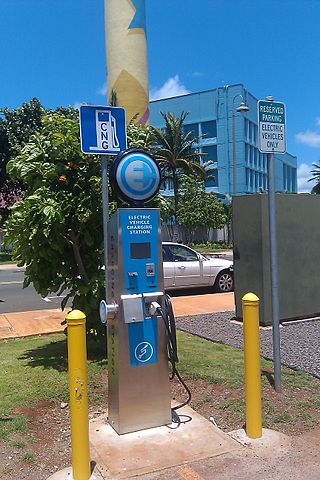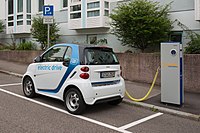Related Research Articles

Electric car use by country varies worldwide, as the adoption of plug-in electric vehicles is affected by consumer demand, market prices, availability of charging infrastructure, and government policies, such as purchase incentives and long term regulatory signals.

Government incentives for plug-in electric vehicles have been established around the world to support policy-driven adoption of plug-in electric vehicles. These incentives mainly take the form of purchase rebates, tax exemptions and tax credits, and additional perks that range from access to bus lanes to waivers on fees. The amount of the financial incentives may depend on vehicle battery size or all-electric range. Often hybrid electric vehicles are included. Some countries extend the benefits to fuel cell vehicles, and electric vehicle conversions.

The adoption of plug-in electric vehicles in Australia is driven mostly by state-based electric vehicle targets and monetary incentives to support the adoption and deployment of low- or zero-emission vehicles. The monetary incentives include electric vehicle subsidies, interest-free loans, registration exemptions, stamp duty exemptions, the luxury car tax exemption and discounted parking for both private and commercial purchases. The Clean Energy Finance Corporation, energy providers, car loan providers and car insurance providers also offer their own financial incentives for electric vehicle purchases including Macquarie Bank offering the lowest electric car loan of 2.99%.

As of 18 April 2023, there were 185,511 electric vehicles registered in Texas.

As of June 2023, there were about 26,000 electric vehicles registered in Hawaii. The state has the second-highest number of electric vehicles per capita in the United States, behind California.

As of November 2021, there were about 41,000 electric vehicles in Maryland.
As of July 2022, there were about 25,000 electric vehicles registered in Connecticut. About 25% of vehicles registered in the state between July and December 2021 were electric.
As of March 2021, there were about 4,000 electric vehicles in Delaware. As of May 2023, there were just 142 charging locations located in Delaware, putting Delaware in the bottom 10 states for charging stations in the US. According to official sources only 11 new charging stations have been added in the past two years. Information for Delaware's laws and incentives for electric vehicles can be found at the United States Department of Energy's Alternative Fuel Data Center.
As of March 2022, there were about 4,900 electric vehicles in Rhode Island, equivalent to 0.7% of all vehicles in the state.
As of 2021, there were about 9,000 electric vehicles registered in Wisconsin.
As of March 2021, there were about 3,500 electric vehicles registered in Alberta, equivalent to about 0.1% of all vehicles in the province. As of 2022, around 2.3% of new cars sold in Alberta were electric.
As of October 2021, there were about 67,000 electric vehicles in Ontario. As of 2021, about 3% of new vehicle registrations in Ontario were electric.
As of March 2022, there were about 76,000 fully electric vehicles and 57,000 plug-in hybrid vehicles in Quebec. As of 2021, about 6.8% of new vehicle registrations in Quebec were electric.
As of April 2021, there were about 7,000 electric vehicles registered in Indiana.
As of February 2023, there were 7,150 electric vehicles registered in Louisiana.
As of September 2021, there were 10 battery electric vehicles and 12 plug-in hybrid vehicles registered in the Northwest Territories.
As of September 2022, there were about 2,600 electric vehicles in Nebraska, equivalent to 0.2% of all vehicles in the state.
As of 2020, about 0.45% of all new vehicle sales in West Virginia were electric.
As of December 2021, there were around 31,000 electric vehicles registered in Malaysia. As of 2021, about 0.05% of new cars sold in Malaysia were electric.
The adoption of electric vehicles in Singapore is supported by the Singapore government via the Singapore Green Plan 2030 to have new car models required to run on cleaner energy sources and installation of up to 60,000 electric vehicle charging stations. Financial incentives are given to the public for installation of charging points and purchase of electric cars.
References
- ↑ Labbé, Stefan (April 1, 2022). "B.C. tops Quebec and California as EV capital of North America". Vancouver is Awesome. Retrieved April 20, 2022.
- ↑ "B.C. to benefit as Parkland doubles western Canada EV charging network". Victoria News. December 2, 2022. Retrieved December 25, 2022.
- ↑ "The Clean Energy Vehicle (CEV) Program". LiveSmart BC. November 5, 2011. Archived from the original on November 14, 2011. Retrieved November 13, 2011.
- ↑ "Table 1 –Examples of Clean Energy Vehicles and Incentive Levels" (PDF). LiveSmart BC. Archived from the original (PDF) on April 3, 2012. Retrieved November 13, 2011.
- ↑ Kumarasamy, Pira (April 20, 2022). "Gas vs. Electric Vehicle: Here's What to Consider". Morningstar. Retrieved April 20, 2022.
- ↑ Molnar, Coleman (February 23, 2022). "B.C. will no longer collect PST on used battery-electric vehicle sales". Driving.ca. Retrieved April 20, 2022.
- ↑ Orton, Tyler (March 22, 2022). "Supply, infrastructure issues stalling mass EV adoption" . Retrieved April 20, 2022.
- ↑ "Province expanding electric vehicle charging network". BC Gov News. August 31, 2021. Retrieved April 20, 2022.
- ↑ McSheffrey, Elizabeth (December 7, 2021). "New report urges B.C. to become region's leader in recycling electric vehicle batteries". Global News. Retrieved April 20, 2022.
- ↑ Canseco, Mario (May 2, 2022). "Opinion: Shift to electric vehicle acceptance is accelerating slowly in B.C." Coast Reporter. Retrieved May 7, 2022.
- ↑ "Would-be EV buyers in B.C. stymied by supply issues, report finds". CTV News. May 14, 2022. Retrieved May 15, 2022.
- 1 2 3 Olsen, Tyler (July 27, 2022). "Power surge: electric vehicle numbers rise 50% in one year". Fraser Valley Current. Retrieved January 31, 2023.
- ↑ Welsh, Eric (July 2, 2021). "Public electric-vehicle charging network to expand in Chilliwack". Today in BC. Retrieved December 30, 2022.
- ↑ Kergin, Brendan (February 13, 2019). "City councillor wants to get the ball rolling on electric vehicles in Kamloops". Prince George Citizen. Retrieved December 30, 2022.
- ↑ Munro, Rob (September 24, 2021). "Kelowna may make EV charge stations mandatory for new residential developments". infotel.ca. Retrieved December 25, 2022.
- ↑ Coulter, Brendan (May 11, 2022). "Why electric car uptake in rural B.C. is lagging behind big cities". CBC News. Retrieved May 15, 2022.
- ↑ Howell, Mike (April 8, 2022). "Vancouver gas stations, parking lots without EV chargers could face $10,000 annual fee by 2025". Vancouver is Awesome. Retrieved May 8, 2022.
- ↑ Holmes, Tracy (March 13, 2022). "Surrey's electric-vehicle charging network nears 100 stations". North Delta Reporter. Retrieved February 1, 2023.
- ↑ Morneau, Ethan (May 3, 2022). "70% of Vancouver Island drivers find electric vehicles are too expensive (POLL)". Victoria Buzz. Retrieved December 30, 2022.
- ↑ Romphf, Jake (March 4, 2022). "Victoria aims to add 650 public electric vehicle charging stations over 5 years". Victoria News. Retrieved February 1, 2023.
- ↑ Rothwell, Kevin (April 26, 2021). "Vernon expands its electric vehicle fleet". Vernon Matters. Retrieved January 31, 2023.

